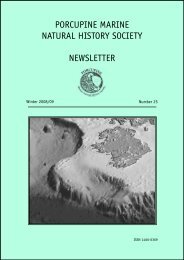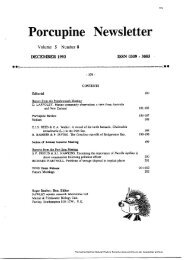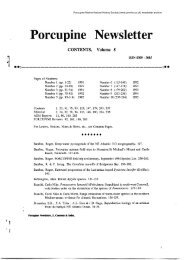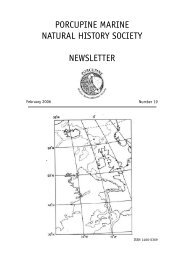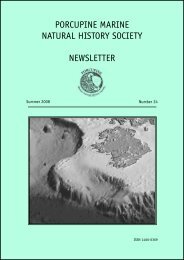Porcupine Newsletter Volume 1, Number 10, August 1980.
Porcupine Newsletter Volume 1, Number 10, August 1980.
Porcupine Newsletter Volume 1, Number 10, August 1980.
You also want an ePaper? Increase the reach of your titles
YUMPU automatically turns print PDFs into web optimized ePapers that Google loves.
-186-<br />
186<br />
PREDATION ON THE PROSOBRANCH HYDROBIA ULVAE BY THE<br />
OPISTHOBRANCH RETUSA OBTUSA<br />
Mike Elliott, F.R.P.B., Estuary Laboratory, Port Edgar,<br />
South Queensferry, Edinburgh.<br />
As part of a study aimed at quantifying the role of intertidal macrofauna in the<br />
Forth Estuary (Elliott, 1979) , the predation on the prosobranch Hydrobia ulvae<br />
(Pennant) by the shelled opisthobranch Retusa obtusa (Montagu) was studied. The<br />
former is one of the more common estuarine intertidal species and the latter is<br />
one of the five species of Retusa found in N. European waters. The two varieties<br />
of R. obtusa (a typical form with a tapering spire and a flat-topped variety<br />
perrenuis) were both found in the estuary.<br />
Hurst (1965) found that R. obtusa does not have a proboscis, buccal mass or radula,<br />
probably feeds by suction and therefore has a large crop and gizzard with internal<br />
plates. During the months September to February Retusae (in the size range 3.7 to<br />
4.8mm) were, found with Hydrobids in their pharynxs, i.e. the prey had been taken<br />
prior to sampling and not digested sufficiently to be withdrawn into the shell. In<br />
some cases the terminal whorl of the Hydrobid had been eroded within the pharynx.<br />
The size range of Hydrobids found in this way was from 1.4 to 2.3mm and increased<br />
with a progression through the year; all were in the 0+ cohort. This data suggests<br />
a larger prey and predator size than those given by Smith (1967). The data suggest<br />
that adult Retusa did not take Hydrobids larger than the 0+ cohort and that young<br />
Retusae utilised spat, foraminiferans, etc.<br />
The population dynamicsofboth species showed that R. obtusa had a life cycle synchronised<br />
to that of its prey, i.e. at the time when the predator was large enough to<br />
feed on Hydrobiae there was the maximum number of appropriate size prey available.<br />
-- R. obtusa reproduced during the period October to February, i.e. the period during<br />
which predation on H. ulvae occurred.<br />
--<br />
The estimation of the production by these species showed, by the use of correlation<br />
matrices and multiple regression analysis, that the most important relationship was<br />
the R. obtusa biomass supported by the production of -- H. ulvae. A large Retusa<br />
biomass resulted from the presence of 0+ group -- H. ulvae on which the adults feed and<br />
other smaller prey items that could be utilised by small Retusae.<br />
The ecological efficiency, as the ratio of food intakes between these two species,<br />
was an order of magnitude lower than that for systems where a prey species almost<br />
totally supports one predator; this reinforces the suggestion that E. ulvae was not<br />
the sole prey of - R. obtusa.<br />
Dr A.J, Berry at Stirling University, using laboratory experiments, is currently<br />
following up many of the ideas expressed above which were based entirely on the<br />
analysis of field data*<br />
--<br />
In addition, although H. ulvae is widely distributed within the estuary, R. obtusa<br />
has been found to have a restricted distribution, both intertidally and sublittorally,<br />
attributable to its direct development and a restricted salinity tolerance as well<br />
as the species' prey availability and possible substrate preferences.<br />
REFERENCES<br />
Elliott, M., 1979. Studies on the production ecology of several Mollusc species<br />
in the Estuarine Firth of Forth. Unpubl. Ph.D. thesis, Univ. of Stirling.<br />
Hurst, A,, 1965. Studies on the structure and function of the feeding apparatus of<br />
Philine aperta with a comparative consideration of some other opisthobranchs.<br />
Malacologia 2_ (3), 281-347.<br />
smith, S.T., 1967. The evolution and life history of Retusa obtusa (Montagu)<br />
(Gastropods, Opisthobranchia). Can.J.Zool. - 45, 397-405.<br />
<strong>Porcupine</strong> Marine Natural History Society (www.pmnhs.co.uk) newsletter archive



